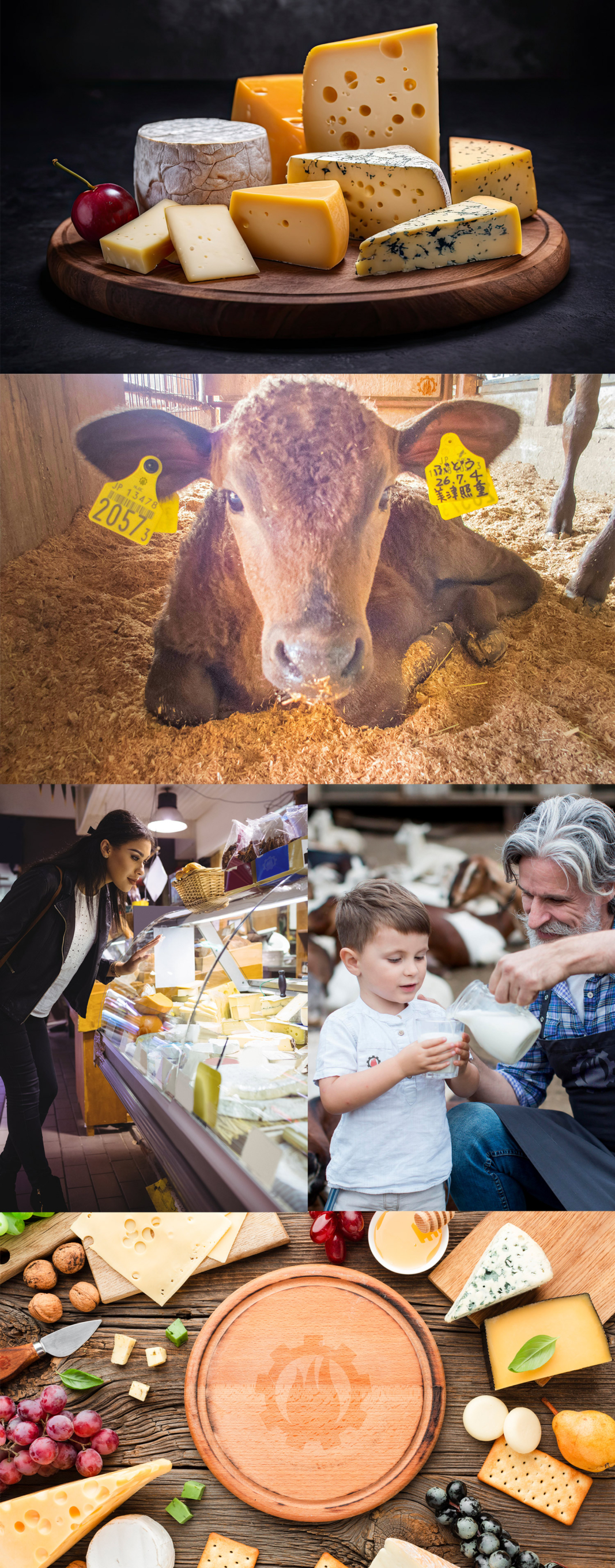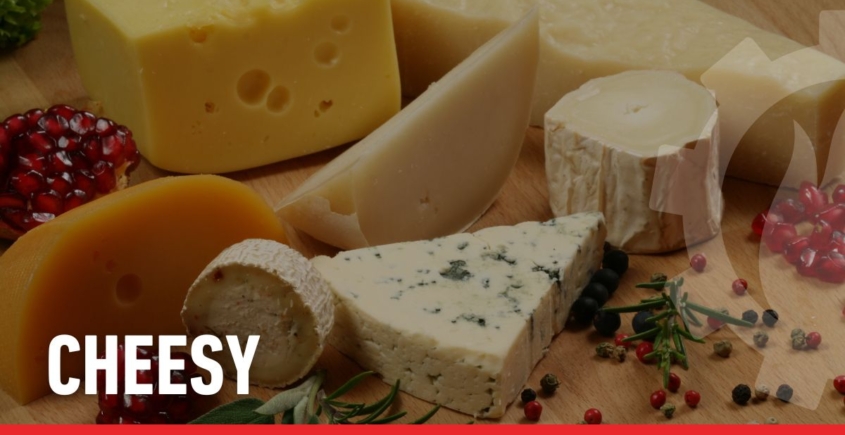Cheesy
Cheese, glorious cheese. I think I just about like every cheese I’ve tasted. I like it cold, gooey warm, and piping hot. I put it on top of food, eat it on crackers (nothing quite like a slice of cheese, a piece of salami on a good cracker with a glass of my favorite vino!), love cheesecake, melt big slabs on my burgers and even go for those little corn curls that make my fingers turn orange. Yep, I’m a cheese lover. I did some digging and found it’s one of humanity’s oldest culinary creations. Research says cheese has been around for nearly 4,000 years and comes in more than 1,800 varieties. Here’s a “sampler platter” of facts about everybody’s favorite dairy product. Thanks to interestingfacts.com, youtube.com, Wikipedia, and Facebook for the info – Enjoy!

According to ancient records passed down through the centuries, the making of cheese dates back more than 4,000 years, but no one really knows who made the first cheese. According to an ancient legend, it was made accidentally by an Arabian merchant who put his supply of milk into a pouch made from a sheep’s stomach, as he set out on a day’s journey across the desert. The rennet in the lining of the pouch, combined with the heat of the sun, caused the milk to separate into curd and whey. That night he found that the whey satisfied his thirst, and the cheese (curd) had a delightful flavor which satisfied his hunger.
(as kids, we were intrigued by cheese – or curds and whey, thanks to Little Miss Muffet. Little Miss Muffet was enjoying a classic dairy treat: curds and whey. While it might sound unfamiliar today, it was a common food in the past. Curds are the solid part of milk that separates when it’s turned into cheese. They’re the basis for many cheeses, including cottage cheese. Whey is the liquid part leftover after the curds are separated. It’s often used in protein supplements and other products. (now you know!)
Travelers from Asia are believed to have brought the art of cheesemaking to Europe. In fact, cheese was made in many parts of the Roman Empire when it was at its height. There are depictions of cheesemaking in the ancient wall paintings and on ceramics. The Romans, in turn, introduced cheesemaking to England.
During the Middle Ages-from the decline of the Roman Empire until the discovery of America-cheese was made and improved by the monks in the monasteries of Europe. For example, Gorgonzola was made in the Po Valley in Italy in 879 A.D., and Italy became the cheesemaking center of Europe during the 10th Century. Roquefort was also mentioned in the ancient records of the monastery at Conques, France as early as 1070.
Cheesemaking continued to flourish in Europe and became an established food. The Pilgrims included cheese in the Mayflower’s supplies when they made their voyage to America in 1620. The making of cheese quickly spread in the New World, but until the 19th century it remained a local farm industry. It wasn’t until 1851 that the first cheese factory in the United States was built by Jesse Williams in Oneida County, New York.
In both ancient Greece and the European Middle Ages, people occasionally tried to predict the future using cheese — a practice known as tyromancy. By some accounts, the holes in the cheese were “read” as omens, much in the same way the shapes that tea leaves form at the bottom of a cup might be interpreted. In other accounts, women attempted to predict their future husbands by writing the names of suitors on scraps of cheese. The first scrap to mold was the “winner. (Jackie does call me “moldy” sometimes 😊).
As population across the United States continued to grow dramatically, the demand for cheese increased and the industry gradually moved westward, centering on the rich farmlands of Wisconsin. In 1845, a band of Swiss immigrants settled in Green County, Wisconsin and started the manufacturing of foreign cheese in America. Most Wisconsin farmers began to believe that their future survival was tied to cheese and their first factory was a Limburger plant which opened in 1868.
The wholesale cheese industry was thus born and showed phenomenal growth during the latter half of the 1800s. By 1880 there were 3,923 dairy factories nationwide which were reported to have made 216 million pounds of cheese that year valued at $17 million. This represented almost 90 percent of total cheese production that year.
By the turn of the century, farm production of cheese had become significant. The 1904 census reported only factory output, which totaled over 317 million pounds. Total natural cheese production grew from 418 million pounds in 1920 to 2.2 billion pounds by 1970.
Rising demand for cheese throughout the 1970s and 1980s brought total natural cheese production to more than 6 billion pounds by the beginning of the 1990s. Processed cheese also experienced a surge in consumer demand with annual production exceeding 2 billion pounds a year by the beginning of the 1990s.
Currently, more than one-third of all milk produced each year in the U.S. is used to manufacture cheese. Recent increases in the overall demand for farm milk have in large part been due to the continued growth of the cheese industry. As consumer appetites for all types of cheese continue to expand, so will the industry.
Surprisingly, nobody really knows for certain why Swiss cheese has holes. The longstanding theory was that bacteria in the cheese emits carbon dioxide, creating bubbles-or “eyes”-that burst as the cheese matures. (Cheese varieties without these eyes are referred to as “blind.”) While this has been the leading hypothesis for the past century, there are other theories. A 2015 study suggests that small particles of hay in milk may cause the famous holes. There’s evidence that these small specks weaken the cheese’s internal structure, causing gas bubbles to emerge.
There’s a reason the scent of certain cheeses smells like feet, armpits, or sweat: The bacteria that make human beings stinky are closely related to the bacteria responsible for stinky cheeses, such as Limburger. In fact, some cheeses are so human-like that mosquitoes can mistake them for flesh.
One of the world’s priciest cheeses? Moose. Made in Sweden, moose cheese is created exclusively at a 59-acre farm that sells the stuff to high-end restaurants for approximately $500 per pound. The cheese is amazingly high in butterfat, making it rich and creamy. Even more pricey is pule, a cheese made from the milk of Serbian donkeys. It reportedly costs about $1700 per pound. (Reviewers say it tastes like manchego.)
In parts of medieval England, it was traditional for a father to buy a cheese — called “groaning cheese” — when his wife gave birth. The cheese was hollowed out and pieces presented to everyone present around the birth. At the child’s christening, the baby would be passed through the wheel of cheese for good luck.
In 2018, researchers separated nine giant wheels of Emmental cheese and played them selections from Mozart’s “The Magic Flute,” Led Zeppelin’s “Stairway to Heaven,” and “Jazz (We’ve Got)” from A Tribe Called Quest, among other sonic selections. The cheeses were exposed to the music 24 hours a day over six months. When food technologists later analyzed the samples, they discovered that the cheese exposed to classical music and rock had a milder flavor compared to a control. As for the hip-hop cheese? It had “a discernibly stronger smell and stronger, fruitier taste than the other test samples.” Researchers are further studying how acoustic waves might affect cheese development.
Each year, about 4% of the world’s cheese supply is stolen — making it the most-stolen food in the world. Cheese, after all, is big business: Global sales exceeded $114 billion in 2019. In Italy, Parmesan is so valuable it can be used as loan collateral, according to CBS News. Consequently, the black market for cheese is thriving. From 2014 to 2016, organized crime was responsible for stealing about $7million of Parmesan. And dairy-based crime definitely isn’t limited to Italy: In 2009, a duo of cheese thieves in New Zealand led police on a high-octane car chase — and tried to throw off the pursuit by tossing boxes of cheddar out the window.






Leave a Reply
Want to join the discussion?Feel free to contribute!